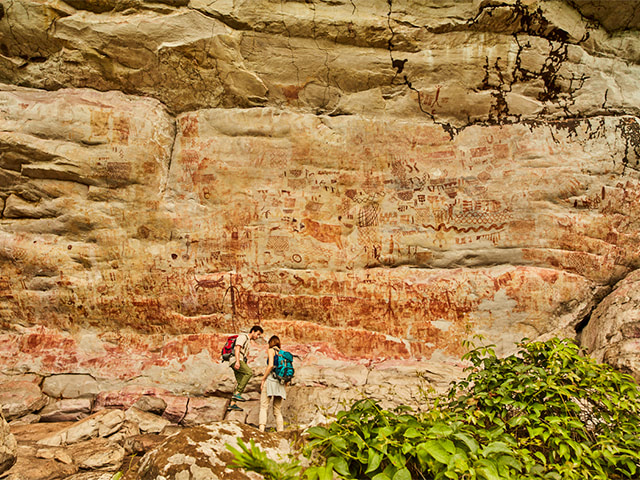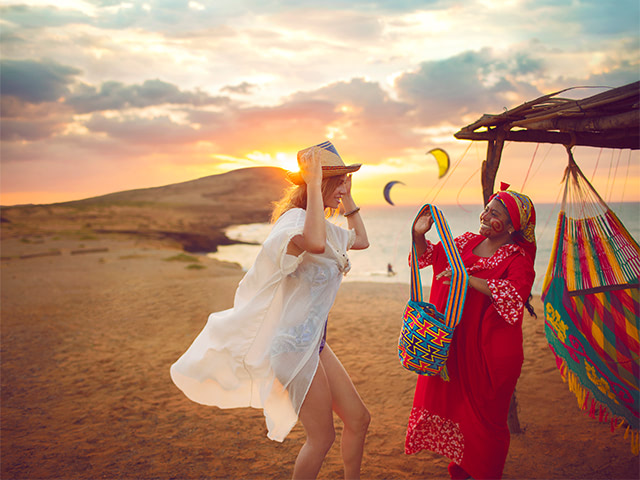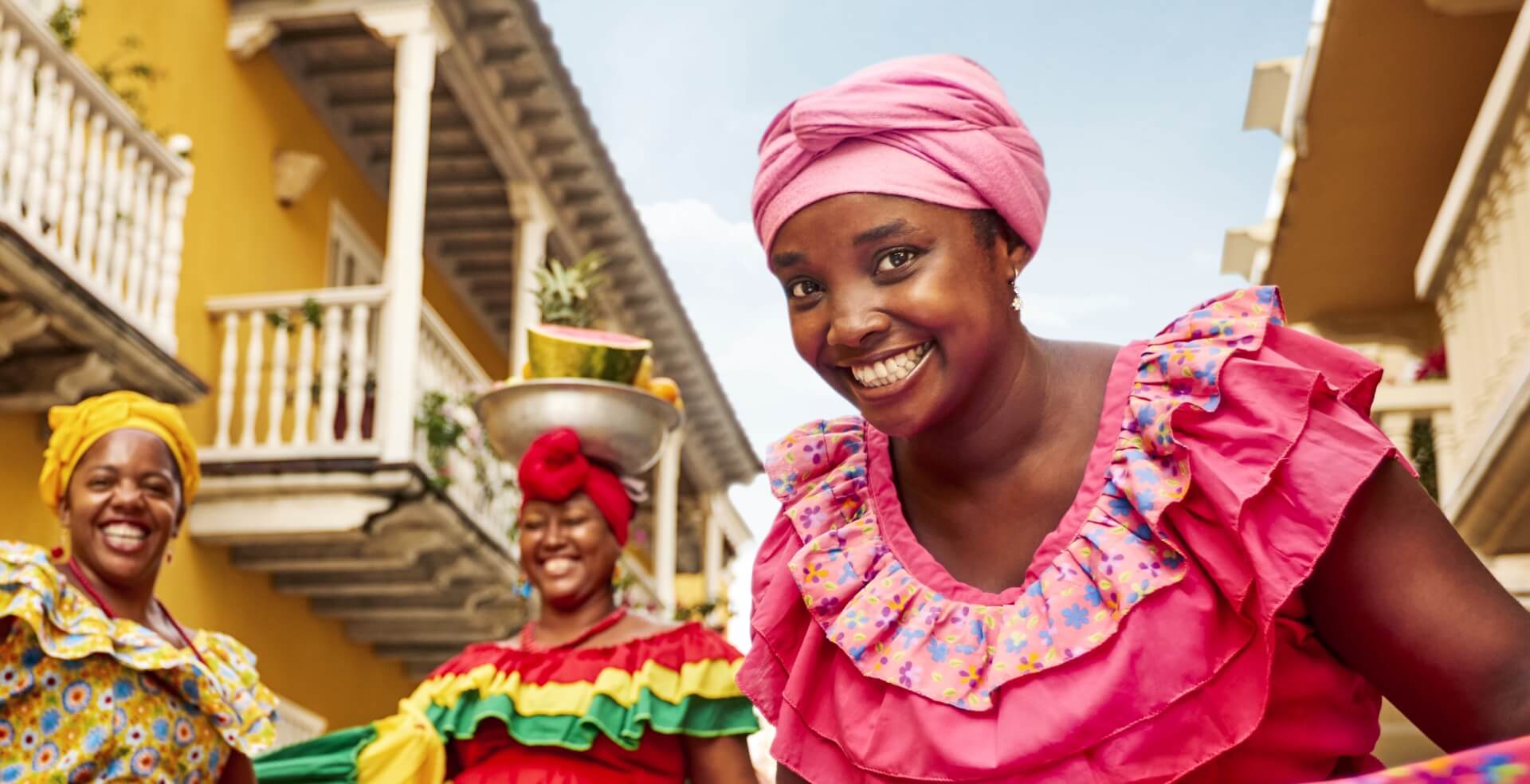Join us on a voyage of discovery with Colombia’s ancient peoples, who are keen to share with you their version of Colombian history and its origins.
Colombian history as told by its indigenous voices
It’s a flashback through the centuries. The story of how Colombian history truly begins. A time when this territory had no national borders, and its inhabitants thrived in a virgin environment, living in harmony with ample vegetation and wildlife.
These spaces and the peoples of old still exist in Colombia and the protagonists have never changed: indigenous communities who are keen to meet visitors, and ensure they enjoy a unique trip to Colombia, guided by their ancient, much-valued worldview.
Indigenous myths and the prologue to our story

Present: Colombia: More than 500 years after the Spanish conquerors arrived. The sun rises over Punta Gallinas, in La Guajira, the country’s most northerly point and casts its rays over the 87 indigenous groups that are scattered across the country, with 710 dedicated reservations. They include the following peoples:
- Chibchas
- Wayuu
- Kogui
- Wiwa
- Arhuacos
- Tucanos
Just as in a movie, we will examine Colombian history through the origin theories put forward by the country’s largest and most representative indigenous groups. So let’s look at the Colombian myths and legends that explain how everything began:
The world-view of Colombia’s biggest indigenous groups
The vision and explanation of the way the world has evolved varies according to Colombia’s many indigenous peoples. Some center their worldview on the natural world and the elements that surround us. Others use Gods to explain our presence on earth.
In the center of Colombia, in the departments of Cundinamarca, Boyaca and Sandander, the Muisca indigneous people, part of the Chibcha family, once lived in the coldest areas. Their main god was the sun, whom they referred to as Xué. They built temples, offered gifts and performed rites in the honor of this great light that illuminates everyone.
You may also be interested in: Destinos con tradiciones que enamoran
Most good stories are told in chapters and, for the Chibchas, Xué was not their only god, or deity. They spoke too of Bachué, the creator of humanity and the starting point for the existence of Colombia and the rest of the world. Bachué was a woman who emerged from Iguaque lagoon, in Boyaca, in the company of a three-year-old boy. The two of them then went on to populate the earth.
Once the pair had succeeded, they returned to the still waters of the lagoon. This sacred place, close to the town of Villa de Leyva, remains a popular destination for hikers, who brave the challenging weather conditions of the region’s high moorland to reach it.
A new chapter in La Guajira

In the northernmost region of Colombia, in Uribia, which is in the department of La Guajira, live the indigenous Wayuu people, in what is the indigenous capital of the country. The Wayuu do not believe the first people to inhabit earth were human, but were kai (the sun) juya (the rain) kashi (the moon) joutai (the wind) and palaa (the sea) – all of whom were the sons of mma (the earth).
Wayuu means man, or to be human, and this community shares its stories, and its approach to the cosmos, with wider society through its handicrafts, including the emblematic ‘mochila’ bags and ‘chinchorro’ hammocks, hand-woven with eye-catching colors and shapes. A visit to this region is an immersion into a culture that is key to Colombia’s identity.
You may also be interested in: Wayúu settlements
The majesty of the Sierra Nevada de Santa Marta mountains
In an enchanting setting, between the Caribbean Sea and the snow-capped peaks of the Sierra Nevada de Santa Marta mountains, live three groups of Colombia's ancestral peoples, each with a special energy. They are the Kogui, Arhuacos and the Wiwa.
They believe a supernatural being was at the origin of everything, a long, long time ago: Mother Nature. She had nine daughters, including the earth, which was her only fertile offsoring and a living being that has accompanied us ever since. Except the Kogui fear that, many thousands of years later, humans have broken their balance with nature.
Colombian history is a history of the world for its many and varied indigenous groups. As in any great mystery movie, discovering their secrets takes patience and attention to detail.
Any trip to this part of Colombia will reveal true treasures, including the ancient Ciudad Perdida or Lost City, a sacred place, and the aim of a long hike through the jungle, which takes every intrepid visitor back in time, especially when they pay attention to the stories and traditions of the indigenous groups that are told along the way.
Visit the many mythological places in Colombia
Historians have long known that there is never just one story that charts the history of a place, but many and multiple viewpoints. The story of Colombian history seen through the eyes of its indigenous inhabitants means opening your heart and mind to an alternate view. Just like in any interactive movie, you can choose the destination and discover what lies behind the country’s many charms.
Be prepared to discover worlds you were previously unaware of, infused with a special and specific energy and purpose. You will need to secure a guide who, with advance permission, can bring you closer to the country’s indigenous communities and help you seek their vision and understanding of their sacred lands.
The soul of Colombia
One last stop on your journey through indigenous history and beliefs will take you to Colombia’s capital, Bogota. Enjoy the city’s art and culture then travel into the soul of the ancient Chibcha people, by visiting Guatavita lagoon. The sight of your reflection shimmering in this emerald lake might just be your key to unlocking the Legend of El Dorado, which you can learn more about at the city’s famous Gold Museum.
Visiting Colombia’s most ancient and sacred territories is the best way to learn from the beliefs and ways of life of indigneous communities such as the Wayuu and Kogui. Such an experience will only enrich your understanding of the history of the world and its people, and how the story of Colombia intertwines.
You may also be interested in: The Gold Museum, a magic treasure in the center of Bogota



















